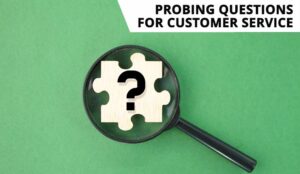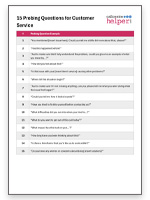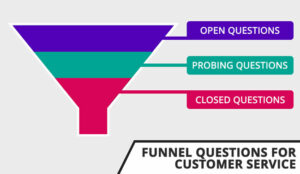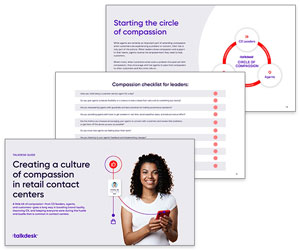Want to ensure your agents truly understand your customers’ problems? The key lies in asking the right questions.
Probing questions help uncover deeper insights, allowing agents to respond to real needs rather than assumptions.
By integrating these types of questions into customer conversations, you can enhance customer experience, boost First Contact Resolution (FCR) rates, and build stronger relationships.
What Is a Probing Question and Why Is It So Important?
A probing question is an open ended question that you ask to gain greater insight into what someone has just told you.
Asking probing questions in customer service can help you improve the overall experience by responding to a customer’s actual needs instead of making assumptions. It can also help to improve First Contact Resolution (FCR) rates.

“We ask probing questions for an important purpose, and that is to understand how they feel. If you can understand how they feel, you can understand why they have contacted you and, crucially, how you can best help them.” said Neil Martin, Creative Director at The First Word
15 Probing Questions Examples for Customer Service or Technical Support Calls
Here are some examples of probing questions – also known as probe questions – that can be used during call centre customer conversations to help gather more information and better understand customers’ feelings.
1. “You Mentioned [Insert Issue Here]. Could You Tell Me a Little Bit More About That, Please?”
It is often the case that a customer will provide a really long response to your opening question, but you want to focus on the issue at hand.
Active listening and probing questions (such as the one mentioned immediately above) will enable you to do that.
To develop you agents’ active listening skills, read our article: How to Train Active Listening in the Call Centre – With Four Exercises
2. “Has This Happened Before?”
Understanding this will tell you whether the problem is a one-off incident or systemic.
You can also gain insight into how to solve the issue by asking the customer how they’ve dealt with the issue previously.
3. “Just to Make Sure That I Fully Understand the Problem, Could You Give Me an Example of What You Mean By…?”
When customers fail to explain the issue clearly, help them out by asking for an example. This will clear things up for you and make it simpler for the customer to articulate their problem.
4. “How Did You Feel About That?”
This question is one to ask once you’ve built rapport, as you can then feel more confident in directly asking the customer about how the situation has impacted them – without startling them.
5. “Is This Issue with Your [Insert Item/ Service] Causing Other Problems?”
If the problem is preventing the customer from doing anything else, we can realize just how frustrating the issue is for them, setting us up for a sincere apology with a show of genuine empathy.
6. “When Did This Situation Begin?”
Establishing when the problem began is key to isolating the root cause.
Establishing when the problem began is key to isolating the root cause.
This will also give the agent greater insight into how long the customer has been suffering with the problem, which has the potential to influence their next steps.
7. “Just to Make Sure I’m Not Missing Anything, Can You Please Tell Me What You Were Doing When the Issue First Began?”
It’s also key to find out whether the customer inadvertently created the issue themselves. You just need to be careful about how you frame it so you do not sound accusatory.
8. “Could You Tell Me How It Looks / Sounds?”
You need to gain an understanding of the whole picture.
If you can better visualize the problem, you may be able to link it back to something you’ve previously come across for a faster resolution.
9. “Have You Tried To Fix This Yourself Before Contacting Us?”
By getting to grips with the actions the customer has taken to resolve the issue, you can ensure that you are not passing on any advice that has previously failed.
10. “What Difficulties Did You Run Into When You Tried To…?”
If the customer has tried to fix the issue themselves, look more closely at this. There may be reason in their logic, meaning that you can work together to problem-solve.
11. “What Do You Want To Get Out Of This Call Today?”
Sometimes customers expect you to be mind-readers in solving their problems. This question can help you to gauge customer expectations and manage them thereafter.
For more on managing customer expectations, read our article: How to Manage and Exceed Customer Expectations – With Examples
12. “What Impact Has This Had On Your…?”
Knowing this will help you to determine the customer’s main priorities. With these priorities, you can find the best possible solution and adapt your approach in respect of this.
13. “How Long Have You Been Thinking About This?”
How often you think about something is a reflection of how much you care about it. If it’s a long time, this is a cue to show real empathy and start to put things right.
For practical advice on training advisors to use empathy in the contact centre, read our article: How to Coach Empathy in the Contact Centre – With Three Training Exercises
14. “Is There a Timeframe That You’d Like Us To Work Within?”
Does the customer have an important event coming up? How urgent is their request?
This will help give you a sense of the importance of the matter to the customer and it also sets you up to manage their expectations.
15. “Do You Have Any Worries or Concerns About Doing [Insert Solution]?”
If the customer does not sound convinced by the solution that you’ve put forward, this probing question will give them the opportunity to raise any concerns.
Printable – 15 Examples of Probing Questions for Customer Service
Do you want to download this to share with your team?
Get your free download of 15 Examples of Probing Questions for Customer Service now:
Examples of Probing Questions for Billing Enquires
Probing questions are also very useful to discover more information when customers ring the call centre for billing enquiries,.
Examples of probing questions for billing include:
- “Can you describe the specific issue you’re experiencing with your bill?”
- “Are there any charges on your bill that you don’t recognize or understand?”
- “Can you walk me through the charges on your latest bill that you have questions about?”
- “Does this apply to just this bill, or to previous months?”
- “Have you contacted us before about this issue, and if so, what was the outcome?”
- “Have you encountered any difficulties making a payment recently?”
- “Is there a particular reason why you might have missed a payment or why a payment was declined?”
Probing vs. Clarifying Questions
Though closely related, clarifying questions and probing questions are fundamentally different in both nature and intent. Clarifying questions are typically brief and are designed to clarify the subject being discussed. For example, “Is this what you said?” and “Did I summarize what you said correctly?”.
Want More Advice on Having Better Conversations?
For more advice on coaching advisors to have better conversations with customers, read our articles:
- Positive Customer Service Language for Positive Conversations
- Customer Psychology: The Key to Better Contact Centre Conversations
- Replace Negative Words With Positive Alternatives for Customer Service
Author: Megan Jones
Reviewed by: Robyn Coppell
Published On: 2nd Jun 2023 - Last modified: 30th Jan 2025
Read more about - Customer Service Strategy, Empathy, Featured Articles, Language, Neil Martin, Questioning Techniques, Rapport





































